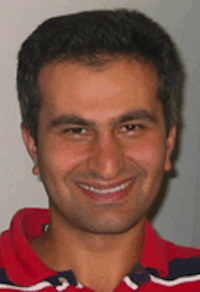Tailored breast cancer screening model developed
How early and how often should women have mammograms?
In theory, it’s, “Annually, beginning at age 40.” As of late, however, that answer has been up for debate — in part because of the risk of false positives, unnecessary biopsies, and the fear and anxiety that go along with such a diagnosis — and the answer has shifted to a more ambiguous, “It depends.”

Alagoz
A University of Wisconsin–Madison engineer has developed a decision-making model that will yield a much more definitive answer. With the model, Oguzhan Alagoz, associate professor of industrial and systems engineering, can tailor mammography decisions to fit an individual’s calculated risk of invasive breast cancer — rather than their age bracket.
Alagoz described his model in the September/October issue of Operations Research.
What makes Alagoz’s model unique is that it incorporates not only a patient’s personal risk factors, such as genetics and age, but also her history of screening. “We illustrate how this extra piece of information might change which decision is optimal and help doctors make better screening decisions,” Alagoz says. “Unlike other cancers such as colorectal, none of the existing breast cancer population-based guidelines currently consider this.”
While the American Cancer Society and other groups still recommend 40 as the start of annual screenings, the U.S. Preventive Services Task Force in 2011 changed the starting age to 50, with decisions about screening at younger ages left to individual women and their doctors. Because some cancers grow more slowly than others, screening has different benefits for different women. The trick is maximizing those benefits while minimizing the harms of over- or under-screening.
Alagoz’s model relies on sequential decision-making techniques, which account for decisions that are made multiple times and have a cascading effect, such as an abnormal mammogram prompting a woman to have another mammogram in six months, or certain cancer risk factors prompting earlier and more frequent mammogram recommendations.
“Our model might help reduce the number of unnecessary mammograms, which account for approximately $100 million in overspending per year in the United States.”
Oguzhan Alagoz
With Alagoz’s model, the need for mammography would depend on a woman’s individual risk of cancer, calculated from a series of factors, including the woman’s family history and lifestyle, but also her previous screening history. The calculated risk of cancer — and risk of “transition” to new states such as biopsy and treatment — would decrease with several consecutive negative test results, to the extent that physicians might not recommend mammography at all for a patient for periods of several years.
In comparing the personalized decision-making strategy to a standard population-based screening recommendation, Alagoz says his model can increase the quality of life and number of years a woman enjoys, while also decreasing how many mammograms the population as a whole receives compared to the once-a-year population-based guidelines. “Our model might help reduce the number of unnecessary mammograms, which account for approximately $100 million in overspending per year in the United States,” Alagoz says.
He says personalizing screening to individuals might be a better way to save the lives of those with a high risk of mortality while reducing the chance that women with a low breast cancer risk will undergo the pain, stress or radiation exposure of unnecessary screenings or treatment.
As an added benefit, Alagoz says his model can create a single easy statistic to describe multiple risk factors, a point that might ease communication among the radiologist, patient and referring physician, and perhaps even facilitate shared decision-making in a more partnership-oriented patient-clinician relationship.
Tags: cancer, engineering, health & medicine



